Remarks on Two-Loop Free Energy in N=4 Supersymmetric Yang-Mills Theory at Finite Temperatu
Paper Two:Energy in Transition
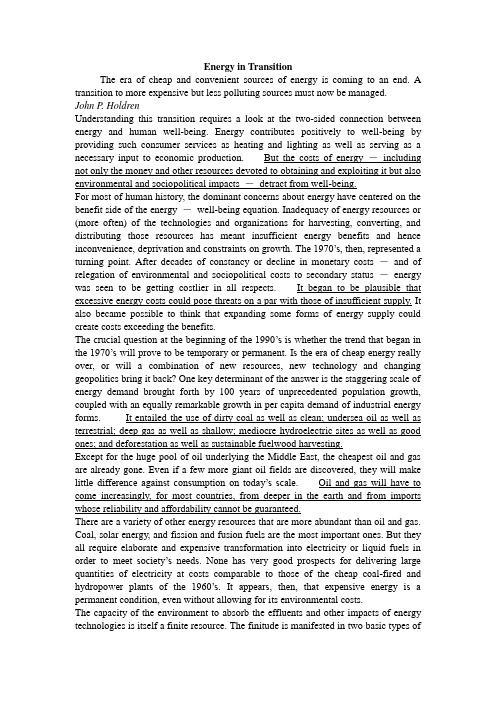
Energy in TransitionThe era of cheap and convenient sources of energy is coming to an end. A transition to more expensive but less polluting sources must now be managed.John P. HoldrenUnderstanding this transition requires a look at the two-sided connection between energy and human well-being. Energy contributes positively to well-being by providing such consumer services as heating and lighting as well as serving as a necessary input to economic production. But the costs of energy -including not only the money and other resources devoted to obtaining and exploiting it but also environmental and sociopolitical impacts -detract from well-being.For most of human history, the dominant concerns about energy have centered on the benefit side of the energy -well-being equation. Inadequacy of energy resources or (more often) of the technologies and organizations for harvesting, converting, and distributing those resources has meant insufficient energy benefits and hence inconvenience, de privation and constraints on growth. The 1970’s, then, represented a turning point. After decades of constancy or decline in monetary costs -and of relegation of environmental and sociopolitical costs to secondary status -energy was seen to be getting costlier in all respects. It began to be plausible that excessive energy costs could pose threats on a par with those of insufficient supply. It also became possible to think that expanding some forms of energy supply could create costs exceeding the benefits.The crucial question at the beginning of the 1990’s is whether the trend that began in the 1970’s will prove to be temporary or permanent. Is the era of cheap energy really over, or will a combination of new resources, new technology and changing geopolitics bring it back? One key determinant of the answer is the staggering scale of energy demand brought forth by 100 years of unprecedented population growth, coupled with an equally remarkable growth in per capita demand of industrial energy forms. It entailed the use of dirty coal as well as clean; undersea oil as well as terrestrial; deep gas as well as shallow; mediocre hydroelectric sites as well as good ones; and deforestation as well as sustainable fuelwood harvesting.Except for the huge pool of oil underlying the Middle East, the cheapest oil and gas are already gone. Even if a few more giant oil fields are discovered, they will make little difference against consumption on today’s scale. Oil and gas will have to come increasingly, for most countries, from deeper in the earth and from imports whose reliability and affordability cannot be guaranteed.There are a variety of other energy resources that are more abundant than oil and gas. Coal, solar energy, and fission and fusion fuels are the most important ones. But they all require elaborate and expensive transformation into electricity or liquid fuels in order to meet society’s needs. None has very good prospects for delivering large quantities of electricity at costs comparable to those of the cheap coal-fired and hydropower plants of the 1960’s. It appears, then, that expensive energy is a permanent condition, even without allowing for its environmental costs.The capacity of the environment to absorb the effluents and other impacts of energy technologies is itself a finite resource. The finitude is manifested in two basic types ofenvironmental costs. External costs are those imposed by environmental disruptions on society but not reflected in the monetary accounts of the buyers and sellers of the energy. “Internalized costs” are increases in monetary costs imposed by measures, such as pollution-control devices, aimed at reducing the external costs.Both types of environmental costs have been rising for several reasons. First, the declining quality of fuel deposits and energy-conversion sites to which society must now turn means more material must be moved or processed, bigger facilities must be constructed and longer distances must be traversed. Second, the growing magnitude of effluents fr om energy systems has led to saturation of the environment’s capacity to absorb such effluents without disruption. Third, the monetary costs of controlling pollution tend to increase with the percentage of pollutants removed.Despite these expenditures, the remaining uninternalized environmental costs have been substantial and in many cases are growing. Those of greatest concern are the risk of death or disease as a result of emissions or accidents at energy facilities and the impact of energy supplied on the global ecosystem and on international relations. The impacts of energy technologies on public health and safety are difficult to pin down with much confidence. In the case of air pollution from fossil fuels, in which the dominant threat to public health is thought to be particulates formed from sulfur dioxide emissions, a consensus on the number of deaths caused by exposure has proved impossible. Widely differing estimates result from different assumptions about fuel compositions, air pollution control technology, power-plant sitting in relation to population distribution, meteorological conditions affecting sulfate formation, and, above all, the relation between sulfate concentrations and disease.Large uncertainties also apply to the health and safety impacts of nuclear fission. In this case, differing estimates result in part from differences among sites and reactor types, in part from uncertainties about emissions from fuel-cycle steps that are not yet fully operational (especially fuel reprocessing and management of uranium-mill tailings) and in part from different assumptions about the effects of exposure to low-dose radiation. The biggest uncertainties, however, relate to the probabilities and consequences of large accidents at reactors, at reprocessing plants and in the transport of wastes.Altogether, the ranges of estimated hazards to public health from both coal-fired and nuclear-power plants are so wide as to extend from negligible to substantial in comparison with other risks to the population. There is little basis, in these ranges, for preferring one of these energy sources over the other. For both, the very size of the uncertainty is itself a significant liability.Often neglected, but no less important, is the public health menace from traditional fuels widely used for cooking and water heating in the developing world. Perhaps 80 percent of global exposure to particulate air pollution occurs indoors in developing countries, where the smoke from primitive stoves is heavily laden with dangerous hydrocarbons. A disproportionate share of this burden is borne, moreover, by women (who do the cooking) and small children (who indoors with their mothers).The ecological threats posed by energy supply are even harder to quantify than the threats to human health and safety from effluents and accidents. Nevertheless, enoughis known to suggest they portend even larger damage to human well-being. This damage potential arises from the combination of two circumstances.First, civilization depends heavily on services provided by ecological and geophysical processes such as building and fertilizing soil, regulating water supply, controlling pests and pathogens, and maintaining a tolerable climate; yet it lacks the knowledge and the resources to replace nature’s s ervices with technology. Second, human activities are now clearly capable of disrupting globally the processes that provide these services. Energy supply, both industrial and traditional, is responsible for a striking share of the environmentalimpacts of human activity. The environmental transition of the past 100 years -driven above all by a 20-fold increase in fossil-fuel use and augmented by a tripling in the use of traditional energy forms -has amounted to no less than the emergence of civilization as a global ecological and geochemical force.Of all environmental problems, the most threatening, and in many respects the most intractable, is global climate change. And the greenhouse gases most responsible for the danger of rapid climate change come largely from human endeavors too massive, widespread and central to the functioning of our societies to be easily altered: carbon dioxide (CO2) from deforestation and the combustion of fossil fuels; methane from rice paddies, cattle gusts and the exploitation of oil and natural gas; and nitrous oxides from fuel combustions and fertilizer use.The only other external cost that might match the devastating impact of global climate change is the risk of causing or aggravating large-scale military conflict. One such threat is the potential for conflict over access to petroleum resources. Another threat is the link between nuclear energy and the spread of nuclear weapons. The issue is hardly less complex and controversial than the link between CO2 and climate; many analysts, including me, think it is threatening indeed.Notes:plausible: a.(of a statement, an excuse, etc.) seeming to be right or reasonable; believable (指陈述﹑藉口等)似乎正确的,似有道理的,可信的on a par with: equal to 等同于staggering: a. astonishing; astounding 惊人的unprecedented: a.never having happened before史无前例的,空前的effluent: n.liquid waste material that comes out of factories or sewage works工业废水magnitude: n. size; degree; extent 程度pin down: define precisely; determine; discover 准确界定;确定;准确认识particulate: n. minute particle or material composed of such particles 微粒;颗粒sulfur dioxide: chemical compound with the formula SO2. It is produced by volcanoes and in various industrial processes. Since coal and petroleum often contain sulfur compounds, their combustion generates sulfur dioxide. 二氧化硫concentration: n. density 浓度liability: n. something that may cause embarrassment or problems; disadvantage 不利因素portend: v. predict; signify预示pathogen: n. disease-producing agent, esp. a virus, bacterium, or other microorganism 病原体,致病菌augment: v. increase增加;增大intractable: a. hard to control or deal with难处理的aggravate: v. make (a problem, injury, or offence) worse or more serious; intensify; annoy使恶化,加重;使恼火。
全国大学英语CET四级考试试卷及答案指导(2025年)

2025年全国大学英语CET四级考试模拟试卷及答案指导一、写作(15分)CET-4 Writing SectionDirections: For this part, you are allowed 30 minutes to write a short essay entitled “The Importance of Teamwork”. You should write at least 120 words but no more than 180 words.Sample Essay: The Importance of TeamworkIn today’s fast-paced and highly competitive world, the concept of teamwork has become more crucial than ever. It is often said that one can go fast alone, but to go far, one must go together. This saying underlines the importance of teamwork in achieving common goals effectively and efficiently.Teamwork allows for the pooling of diverse skills and talents, which leads to more innovative solutions and better decision-making. When individuals with different backgrounds and expertise collaborate, they bring unique perspectives to the table, fostering an environment where creativity thrives. Furthermore, working as a team builds a support system, enabling members to rely on each other during challenging times, thus reducing stress and increasing job satisfaction.Another significant benefit of teamwork is the ability to accomplish tasksthat would be impossible for an individual to handle. By dividing work among team members based on their strengths, teams can tackle complex projects, ensuring all aspects are thoroughly covered. This not only improves the quality of work but also accelerizes the completion time.In conclusion, the value of teamwork cannot be overstated. It is through collaboration and mutual support that we can achieve great things, overcome obstacles, and reach our full potential. Embracing the spirit of teamwork is essential for both personal and professional success in our interconnected world.Analysis:•Introduction: The essay begins with a clear statement about the increasing significance of teamwork in the modern era, setting up the main argument.•Body Paragraphs:•The first body paragraph discusses how teamwork enhances innovation and decision-making by combining varied skills and viewpoints.•The second body paragraph highlights the supportive nature of teamwork, emphasizing its role in managing stress and boosting morale.• A third point is made about the efficiency and effectiveness gained from dividing labor according to individual strengths, allowing for thesuccessful execution of complex tasks.•Conclusion: The concluding paragraph reinforces the thesis, summarizing the key benefits of teamwork and linking them to broader concepts ofachievement and personal growth.This sample response adheres to the word limit (156 words), maintains a coherent structure, and provides specific examples to support the main points, making it a strong example for the CET-4 writing section.二、听力理解-短篇新闻(选择题,共7分)第一题News Item 1:A new study has found that the popularity of online shopping has led to a significant increase in the use of plastic packaging. The researchers analyzed data from various e-commerce platforms and discovered that the amount of plastic packaging used in online orders has doubled over the past five years. This has raised concerns about the environmental impact of e-commerce and the need for more sustainable packaging solutions.Questions:1、What is the main issue addressed in the news?A) The decline of traditional shopping methods.B) The environmental impact of online shopping.C) The growth of e-commerce platforms.D) The advantages of plastic packaging.2、According to the news, what has happened to the use of plastic packaging in online orders over the past five years?A) It has decreased by 50%.B) It has remained stable.C) It has increased by 25%.D) It has doubled.3、What is the primary concern raised by the study regarding online shopping?A) The increase in the number of e-commerce platforms.B) The high cost of online shopping.C) The environmental impact of plastic packaging.D) The difficulty in returning products.Answers:1、B) The environmental impact of online shopping.2、D) It has doubled.3、C) The environmental impact of plastic packaging.第二题Section B: Short NewsIn this section, you will hear one short news report. At the end of the news report, you will hear three questions. After each question, there is a pause. During the pause, you must read the four choices marked A), B), C) and D), and decide which is the best answer. Then mark the corresponding letter on the Answer Sheet with a single line through the center.News Report:The World Health Organization announced today that it has added the ChineseSinovac COVID-19 vaccine to its list of vaccines approved for emergency use. This move will facilitate the distribution of the vaccine in lower-income countries participating in the COVAX initiative aimed at ensuring equitable access to vaccines globally. The WHO praised the Sinovac vaccine for its easy storage requirements, making it ideal for areas with less sophisticated medical infrastructure.Questions:1、According to the news report, what did the WHO announce?A)The end of the pandemicB)Approval of a new vaccineC)Launch of a global health campaignD)Increased funding for vaccine researchAnswer: B) Approval of a new vaccine2、What was highlighted about the Sinovac vaccine by the WHO?A)It is the most effective vaccine availableB)It requires simple storage conditionsC)It is cheaper than other vaccinesD)It has no side effectsAnswer: B) It requires simple storage conditions3、What is the purpose of the COVAX initiative mentioned in the report?A)To speed up vaccine developmentB)To provide financial support to vaccine manufacturersC)To ensure equal access to vaccines worldwideD)To promote travel between countriesAnswer: C) To ensure equal access to vaccines worldwide三、听力理解-长对话(选择题,共8分)第一题Part Three: Long ConversationsIn this section, you will hear 1 long conversation. The conversation will be played twice. After you hear a part of the conversation, there will be a pause. Both the questions and the conversation will be spoken only once. After you hear a question, you must choose the best answer from the four choices marked A), B), C), and D). Then mark the corresponding letter on Answer Sheet 2 with a single line through the center.Now, listen to the conversation.Conversational Excerpt:M: Hey, Jane, how was your day at the office today?W: Oh, it was quite a challenge. I had to deal with a lot of issues. But I think I handled them pretty well.M: That’s good to hear. What were the main issues you faced?W: Well, first, we had a problem with the new software we’re tryin g to implement. It seems to be causing some technical difficulties.M: Oh no, that sounds frustrating. Did you manage to fix it?W: Not yet. I’m still trying to figure out what’s wrong. But I’m workingon it.M: That’s important. The company can’t afford a ny downtime with this software.W: Exactly. And then, I had to deal with a customer complaint. The customer was really upset because of a delayed shipment.M: That’s never a good situation. How did you handle it?W: I tried to be understanding and offered a discount on their next order. It seemed to calm them down a bit.M: That was a good move. Did it resolve the issue?W: Yes, it did. They’re satisfied now, and I think we’ve avoided a bigger problem.M: It sounds like you had a busy day. But you did a good job handling everything.W: Thanks, I’m glad you think so.Questions:1、What was the main issue the woman faced with the new software?A) It was causing problems with the computer systems.B) It was taking longer to install than expected.C) It was causing technical difficulties.D) It was not compatible with their existing systems.2、How did the woman deal with the customer complaint?A) She escalated the issue to her supervisor.B) She offered a discount on the customer’s next order.C) She apologized directly to the customer.D) She sent the customer a refund check.3、What was the woman’s impression of her day at work?A) It was uneventful and unchallenging.B) It was quite stressful but rewarding.C) It was a day filled with unnecessary meetings.D) It was a day where she didn’t accomplish much.4、What did the man say about the woman’s day at work?A) He thought it was unproductive.B) He felt she had handled everything well.C) He thought she should have asked for help.D) He believed she should take a break.Answers:1、C2、B3、B4、B第二题对话内容:Man:Hey, Sarah. I heard you’re planning to go on a trip next month. Where are you heading?Sarah:Oh, hi, Mike! Yes, I’m really excited about it. I’m going to Japan. It’s my first time there.Man:That sounds amazing! How long will you be staying? And what places are you planning to visit?Sarah:I’ll be there for two weeks. My plan is to start in Tokyo and then travel to Kyoto, Osaka, and Hiroshima. I’ve always been fascinated by the mix of traditional and modern culture in Japan.Man: Two weeks should give you plenty of time to see a lot. Are you going alone or with someone?Sarah:Actually, I’m going with a group of friends from college. We all decided to take this trip together after graduation. It’ll be great to experience it with them.Man:That’s wonderful! Do you have everything planned out, like accommodations and transportation?Sarah:Mostly, yes. We’ve booked our flights and hotels, and we’re using the Japan Rail Pass for getting around. B ut we’re leaving some room for spontaneity too. Sometimes the best experiences come unexpectedly!Man:Absolutely, that’s the spirit of traveling. Well, I hope you have an incredible time. Don’t forget to try some local food and maybe bring back some souvenirs!Sarah:Thanks, Mike! I definitely won’t miss out on trying sushi and ramen, and I already have a list of gifts to buy for family and friends. I can’t waitto share my adventures with everyone when I get back.1、How long is Sarah planning to stay in Japan?•A) One week•B) Two weeks•C) Three weeks•D) One month答案: B) Two weeks2、Which of the following ci ties is NOT mentioned as part of Sarah’s itinerary?•A) Tokyo•B) Kyoto•C) Sapporo•D) Hiroshima答案: C) Sapporo3、Who is Sarah going to Japan with?•A) By herself•B) With her family•C) With a group of friends•D) With coworkers答案: C) With a group of friends4、What has Sarah and her friends prepared for their trip besides booking flights and hotels?•A) They have hired a personal guide.•B) They have reserved spots for cultural workshops.•C) They have purchased a Japan Rail Pass.•D) They have enrolled in a language course.答案: C) They have purchased a Japan Rail Pass.四、听力理解-听力篇章(选择题,共20分)第一题Section CDirections: In this section, you will hear a passage three times. When the passage is read for the first time, listen carefully for its general idea. When the passage is read for the second time, fill in the blanks with the exact words you have just heard. Finally, when the passage is read for the third time, check what you have written.Passage:In recent years, the concept of “soft skills” has become increasingly popular in the workplace. These are skills that are not traditionally taught in schools but are essential for success in the professional world. Soft skills include communication, teamwork, problem-solving, and time management.1、Many employers believe that soft skills are just as important as technical skills because they help employees adapt to changing work environments.2、One of the most important soft skills is communication. Effectivecommunication can prevent misunderstandings and improve relationships with colleagues.3、Teamwork is also crucial in today’s workplace. Being able to work well with others can lead to better productivity and innovation.4、Problem-solving skills are essential for overcoming obstacles and achieving goals. Employees who can think creatively and solve problems efficiently are highly valued.5、Time management is another key soft skill. Being able to prioritize tasks and manage time effectively can help employees meet deadlines and reduce stress.Questions:1、What is the main idea of the passage?A) The importance of technical skills in the workplace.B) The definition and examples of soft skills.C) The increasing popularity of soft skills in the workplace.D) The impact of soft skills on employee performance.2、Why do many employers believe soft skills are important?A) They are easier to teach than technical skills.B) They are not necessary for most jobs.C) They help employees adapt to changing work environments.D) They are more difficult to acquire than technical skills.3、Which of the following is NOT mentioned as a soft skill in the passage?A) Communication.B) Leadership.C) Problem-solving.D) Time management.Answers:1、C) The increasing popularity of soft skills in the workplace.2、C) They help employees adapt to changing work environments.3、B) Leadership.Second Part: Listening Comprehension - Passage QuestionsListen to the following passage carefully and then choose the best answer for each question.Passage:Every year, millions of people flock to beaches around the world for their vacations. While enjoying the sun and sand, few give much thought to the tiny organisms that make up the very sand they’re lying on. Sand is actually made from rock particles that have been broken down over time by natural processes. However, on some unique beaches, like those found in Hawaii, the sand has a significant component of coral and shell fragments, giving it a distinctive white color. Beaches not only provide relaxation but also play a crucial role in supporting marine life and protecting coastal areas from erosion.Questions:1、What do millions of people go to the beaches for annually?2、What makes the sand on Hawaiian beaches distinctive?3、Besides providing relaxation, what other important role do beaches serve?Answers:1、Vacations.2、The presence of coral and shell fragments.3、Supporting marine life and protecting coastal areas from erosion.第三题PassageThe rise of e-commerce has revolutionized the way we shop. With just a few clicks, customers can purchase products from all over the world and have them delivered to their doorstep. However, this convenience has also brought about some challenges, particularly in terms of logistics and environmental impact.One of the biggest concerns is the environmental impact of packaging. Traditional packaging materials, such as plastic bags and boxes, are not biodegradable and often end up in landfills, contributing to pollution.E-commerce companies have started to address this issue by offering packaging-free options and promoting the use of sustainable materials.Another challenge is the issue of returns. With the ease of online shopping, customers often order more items than they need, leading to a high rate of returns. This not only increases the carbon footprint of shipping but also creates additional waste. Some companies have introduced policies to encourage customers to return fewer items, such as offering incentives for reuse or donation.Despite these challenges, the e-commerce industry is not standing still. There are innovative solutions being developed to make the process more sustainable. For example, some companies are experimenting with drone delivery to reduce the number of vehicles on the road. Others are investing in energy-efficient data centers to power their operations.1、What is one of the main concerns related to e-commerce packaging?A)The high cost of shipping materials.B)The environmental impact of non-biodegradable materials.C)The difficulty in recycling packaging materials.2、How does the high rate of returns affect e-commerce?A)It increases the demand for new packaging materials.B)It leads to a decrease in the cost of shipping.C)It creates additional waste and increases the carbon footprint.3、What is an innovative solution being developed to make e-commerce more sustainable?A)The use of reusable packaging.B)The implementation of strict return policies.C)The introduction of drone delivery.Answers:1、B2、C3、A五、阅读理解-词汇理解(填空题,共5分)First QuestionPassage:In today’s fast-paced world, conservation has become a major concern for environmentalists and policymakers alike. Preserving natural resources is not just about protecting the environment; it also plays a critical role in ensuring sustainable development and improving the quality of life for future generations. Innovative methods are being explored to achieve this goal, including the use of renewable energy sources and promoting eco-friendly practices in industries.Questions:1、The word “conservation” in the passage most likely means:A) The act of using something economically or sparingly.B) The protection of natural resources from being wasted.C) The process of changing something fundamentally.D) The act of restoring something to its original state.Answer: B) The protection of natural resources from being wasted.2、The word “innovative” in the passage is closest in meaning to:A) Outdated.B) Traditional.C) Creative.D) Unchanged.Answer: C) Creative.3、Based on the context, t he term “eco-friendly” would be best described as:A) Practices that are harmful to the environment.B) Practices that are beneficial to the environment.C) Practices that have no impact on the environment.D) Practices that focus solely on economic growth.Answer: B) Practices that are beneficial to the environment.4、The phrase “sustainable development” in the text refers to:A) Development that uses up all available resources quickly.B) Development that meets present needs without compromising the ability of future generations to meet their own needs.C) Development that focuses only on immediate economic gains.D) Development that disregards environmental concerns.Answer: B) Development that meets present needs without compromising the ability of future generations to meet their own needs.5、When the passage mentions “quality of life,” it implies:A) A decrease in living standards over time.B) An improvement in the overall conditions under which people live and work.C) The absence of any efforts to improve living conditions.D) The focus on increasing industrial activities regardless of their impact.Answer: B) An improvement in the overall conditions under which people live and work.This format closely follows the structure you might find in an actual CET Band 4 exam, with a passage followed by vocabulary questions that test understanding of context and word meanings.第二题Reading PassagesIn today’s fast-paced world, staying informed about current events is more important than ever. One of the best ways to keep up with the news is to read newspapers. However, not all newspapers are created equal. Here is an overview of some of the most popular newspapers in the world.1.The New York Times (USA): Established in 1851, The New York Times is one of the most prestigious and influential newspapers in the world. It covers a wide range of topics, including national and international news, politics, business, science, technology, and culture.2.The Guardian (UK): The Guardian is a British newspaper that has been in circulation since 1821. It is known for its liberal bias and its commitment to investigative journalism. The Guardian covers a variety of issues, including politics, the environment, and social justice.3.Le Monde (France): Le Monde is a French newspaper that was founded in 1944. It is one of the most widely read newspapers in France and is known for its in-depth reporting and analysis of global events.4.The Times (UK): The Times is another British newspaper that has been in circulation since 1785. It is a conservative newspaper that focuses on politics, business, and finance.5.El País (Spain): El País is a Spanish newspaper that was founde d in 1976. It is one of the most popular newspapers in Spain and is known for its comprehensive coverage of national and international news.Vocabulary UnderstandingChoose the best word or phrase to complete each sentence. Write your answers in the spaces provided.1、The____________of The New York Times is that it is one of the most prestigious and influential newspapers in the world.a.reputationb.historyc.popularityd.bias2、The Guardian is known for its____________bias and its commitment to investigative journalism.a.liberalb.conservativec.moderated.biased3、Le Monde is one of the most widely read newspapers in France and is known forits____________reporting and analysis.a.shallowb.superficialc.in-depthd.brief4、The Times is a conservative newspaper that focuses on____________issues.a.socialb.economicc.politicald.cultural5、El País is one of the most popular newspapers in Spain and is known for its comprehensive____________of national and international news.a.reportingb.analysisc.coveraged.editorialAnswers:1、a. reputation2、a. liberal3、c. in-depth4、c. political5、c. coverage六、阅读理解-长篇阅读(选择题,共10分)第一题Reading Passage OneIn recent years, with the rapid development of the internet and mobile technology, online learning has become increasingly popular among students. Online courses, such as those offered by MOOCs (Massive Open Online Courses), provide students with convenient access to high-quality educational resources from around the world. However, despite the benefits of online learning, there are also some challenges and considerations that need to be addressed.1.The following passage is about:A. The advantages and disadvantages of online learningB. The impact of online learning on traditional educationC. The history of MOOCs and their role in educationD. The challenges faced by students in online learning2.According to the passage, what is one of the main benefits of online learning?A. It allows students to study at their own paceB. It provides access to a wider range of educational resourcesC. It increases the interaction between students and teachersD. It reduces the cost of education3.The passage mentions that online learning has become increasingly popular due to:A. The advancements in internet technologyB. The decline of traditional education systemsC. The desire for flexible learning schedulesD. All of the above4.What is one of the challenges mentioned in the passage that online learners may face?A. Limited access to technological devicesB. Difficulty in maintaining self-disciplineC. Lack of face-to-face interaction with teachersD. All of the above5.The passage suggests that in order to succeed in online learning, students should:A. Attend online classes regularlyB. Engage in active discussions with peersC. Set clear goals and deadlines for their studiesD. All of the above答案:1.A2.B3.D4.D5.D第二题Reading Passage OneThe rise of the Internet has revolutionized the way we communicate and accessinformation. One of the most significant impacts has been the transformation of education, with online learning becoming increasingly popular. This passage explores the benefits and challenges of online learning.The Benefits of Online Learning1.Flexibility: Online learning offers students the flexibility to study at their own pace and on their own schedule. This is particularly beneficial for working professionals and those with other commitments.2.Access to a Wide Range of Resources: Online courses often provide access to a wealth of resources, including textbooks, videos, and interactive materials that can enhance the learning experience.3.Diverse Learning Opportunities: Online learning platforms offer a wide variety of courses, ranging from traditional academic subjects to specialized and niche areas of study.4.Cost-Effective: Online courses can be more affordable than traditional classroom-based programs, especially for those who live far from educational institutions.The Challenges of Online Learning1.Self-Discipline: Online learning requires a high level of self-discipline and motivation, as students must manage their time and stay focused without the structure of a traditional classroom.2.Limited Interaction: Online courses often lack the face-to-face interaction that is common in traditional classrooms, which can impact the learning experience and social development of students.3.Technical Issues: Online learning relies heavily on technology, which can lead to technical issues that disrupt the learning process.4.Quality Assurance: With the proliferation of online courses, ensuring the quality and integrity of these courses can be a challenge.Questions:1、What is one of the main advantages of online learning mentioned in the passage?A. It is more expensive than traditional education.B. It requires students to be self-disciplined.C. It provides flexibility in studying.D. It lacks face-to-face interaction.2、According to the passage, what can online learning platforms offer that traditional classrooms might not?A. Limited access to textbooks.B. Fewer specialized courses.C. More interactive learning materials.D. No video resources.3、Which of the following is a challenge that online learning may present?A. Students can easily attend classes at a local university.B. There are no technical issues with online learning.C. It is difficult to ensure the quality of online courses.D. Online learning is always more affordable than traditional education.4、The passage suggests that online learning can be beneficial for:A. Students who prefer face-to-face interaction.B. Individuals with other commitments.C. Those who want to avoid textbooks.D. People who have no access to technology.5、What is one potential drawback of online learning that the passage discusses?A. The ability to study at any time.B. The use of a wide range of resources.C. The possibility of technical disruptions.D. The convenience of studying from home.Answers:1、C2、C3、C4、B5、C七、阅读理解-仔细阅读(选择题,共20分)第一题Reading PassagesIn the following passage, there are some blanks. For each blank there arefour choices marked A, B, C, and D. You should choose the one that best fits into the passage.The digital revolution is changing the way we live, work, and communicate. One of the most significant changes is the rise of artificial intelligence (AI). AI refers to the development of computer systems that can perform tasks that typically require human intelligence, such as visual perception, speech recognition, and decision-making.The potential of AI is enormous. It has the potential to transform industries, improve efficiency, and make our lives more convenient. However, with great power comes great responsibility. The ethical implications of AI are complex and multifaceted.1、The passage is mainly aboutA. the benefits of the digital revolutionB. the rise of artificial intelligenceC. the challenges of the digital revolutionD. the ethical implications of AI2、What is the main concern regarding AI mentioned in the passage?A. Its potential to disrupt traditional industriesB. Its potential to replace human jobsC. Its potential to be used for unethical purposesD. Its potential to cause social inequalities3、The author suggests that AI has the potential to。
试题,发电厂动力部分 自考试题,笔记(Test questions, power plants, self test questions, notes)
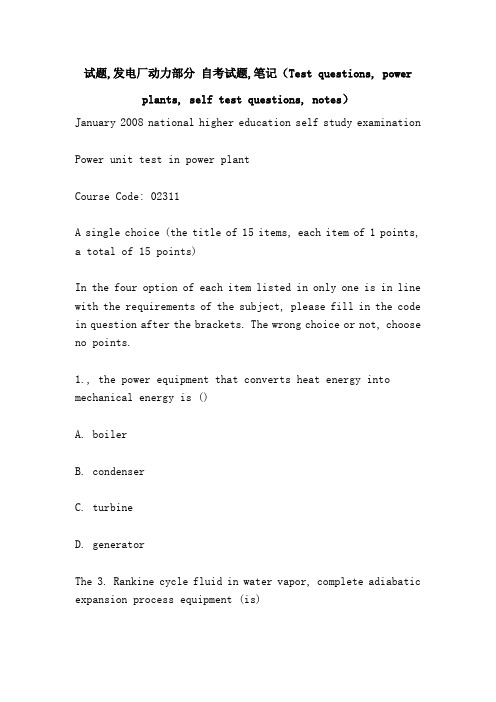
试题,发电厂动力部分自考试题,笔记(Test questions, power plants, self test questions, notes)January 2008 national higher education self study examinationPower unit test in power plantCourse Code: 02311A single choice (the title of 15 items, each item of 1 points, a total of 15 points)In the four option of each item listed in only one is in line with the requirements of the subject, please fill in the code in question after the brackets. The wrong choice or not, choose no points.1., the power equipment that converts heat energy into mechanical energy is ()A. boilerB. condenserC. turbineD. generatorThe 3. Rankine cycle fluid in water vapor, complete adiabatic expansion process equipment (is)A. boilerB. turbineC. condenserD. superheater4. in the case of a known fluid species, the fluid Prandtl number is found in the physical table, based mainly on ()A. pressureB. temperatureC. velocityD. pipe diameter5. the utility model adopts the form of a pulverized coal boiler, and the combustion mode belongs to ()A. layer furnaceB. boiling furnaceC. chamber combustion furnaceD. cyclone furnace6. the following statement about swirl burners is wrongA. long rangeB. has an internal pressure return zoneC. large expansion angleD. has tangential velocity7. the following statement about water film dust collector is wrongA. dust removal efficiency is lowB. smoke circulation resistance is bigC. dust collector is compact in structure and small in sizeD. initial investment is large8., in the many factors that affect the boiler operating conditions, belongs to "outside disturbance" is ()A. coal quality changeB. excess air factor changeC. coal fineness changeLoad change of D. turbo generator unit9. the energy conversion of steam in the high pressure cylinder of a multistage turbine is in a series ofProgressively completed in the series of A. stagesB. in series at the same timeThe C. is completed in parallelD. parallel stages are completed simultaneously10. when the steam temperature is constant and the pressure rises, the steam at the end of the turbine ()A. temperature dropB. temperature riseC. humidity decreasesD. humidity increases11. the role of the ejector in the condenser of the turbine is to draw out the condenserA. airB. steamC. steam and air mixtureD. air and other non condensable gases12. a unit with a large rate of change in turbine speed under certain load changesThe A. speed changes little, and its static characteristic is more gentleB. has little change in speed, and its static characteristics are steepC. changes greatly in speed, and its static characteristics are steepThe D. speed changes greatly, and its static characteristics are more gentle13., the factors that have nothing to do with the standard coal consumption rate of power plants are ()A. factory power consumptionComprehensive utilization method of ash in B. power plantC. boiler efficiencyD. turbine internal lossThe method of regulating output of 14. axis Kaplan turbine is to open large (or close)A. driftmeterB. wheel entrance water guide mechanism gateopeningC. inlet valveBlade opening of D. runner15., the factors that have nothing to do with the annual operating costs of hydropower plants areA. annual average generating capacityB. equipment depreciation expenseC. production management feeD. maintenance costs source: examination - self-study examinationTwo, multiple-choice questions (the big topic 5 items, each item of 2 points, a total of 10 points)In the five option of each item listed in the two to five is in line with the requirements of the subject, please fill in the code in question after the brackets. The wrong choice, multiple choice, choose less or not choose no points.16., the first law of thermodynamics should be applied to closed systems, applicable to ()A. ideal gasB. actual gasC. reversible processD. irreversible processE. work medium expansion17., we want to know the state parameter of saturated saturated steam under known pressure. The specific volume VX should be calculated by the relevant parameters. They are ()18. the function of furnace safety monitoring system (FSSS) has ()A. adjust combustionB. balanced ventilationC. coal pulverizing system and combustion system are standardized and ordered to start and stopWhen the D. meets dangerous conditions, the emergency trip is stopped and the combustion supply and boiler operation are stoppedE. adjust flow rate19. the main monitoring items during the normal operation ofthe steam turbine includeInlet pressure and temperature of A. steam turbineB. condenser vacuumVibration of C. unitD. bearings return oil temperatureE. lubricating oil pressure20. for a constant flow, under any conditions, the following statements are correctA. the cross section is a flat surfaceThe flow velocity at each point on the cross section of the B. is not equalC. the flow across each cross section is equalThe average flow velocity of each cross section of D. is unchangedThe flow directions of the points on the cross section of the water E. are parallel to each otherThree, fill in the blanks (the title of 5 items, each item of 2 points, a total of 10 points)Please fill in the correct answer in each item in the blanks. No fill or no fill.21. the same object radiation temperature and wavelength, with maximum radiation force is ___________. It is ___________ blackness.22. according to the structure and arrangement of different boiler air preheater can be divided into ___________ air preheater and air preheater ___________ two types.23. methods to determine the thermal efficiency of the boiler is mainly ______________________ and _____________________.24. in the power plant, in addition to the 1kg steam turbine generator set in __________ eventually converted into_________The share is the absolute electric efficiency of the turbo generator set.The surface heater 25. thermal power plant feedwater heating system in a pressure ___________ heater and heater ___________ two.Four, explain the problem (the title noun 5 items, each item of 3 points, a total of 15 points)26. superheated steam27. temperature field28. the three impulse regulation of boiler feed water29. partial steam admission of turbine stageVolume loss of 30. hydraulic turbineFive, short answer questions (the big topic 5 items, each item of 6 points, a total of 30 points)31. what is the power cycle? Try to draw the P-V diagram and explain it.32. what are the ways to regulate the steam temperature at the flue gas side of the boiler unit?33. why is the temperature of the upper cylinder always higher than the temperature of the lower cylinder when the steam turbine is running?34. briefly describe the tasks of the steam turbine governing system.35. why is it more efficient to install a stern tube than a no tail pipe?Six, analysis problem (the problem consists of 2 items, each item of 10 points, a total of 20 points)36., what is the mode of feed water heat cycle? Why should modern large thermal power plants adopt the water supply heat cyclemode?37., try to analyze why thermal power plant boilers are equipped with automatic soot blowing devices at all levels, and periodically sweep the heating surface, which can improve the thermal efficiency of power plants.。
Ecole Normale Sup'erieure de Lyon
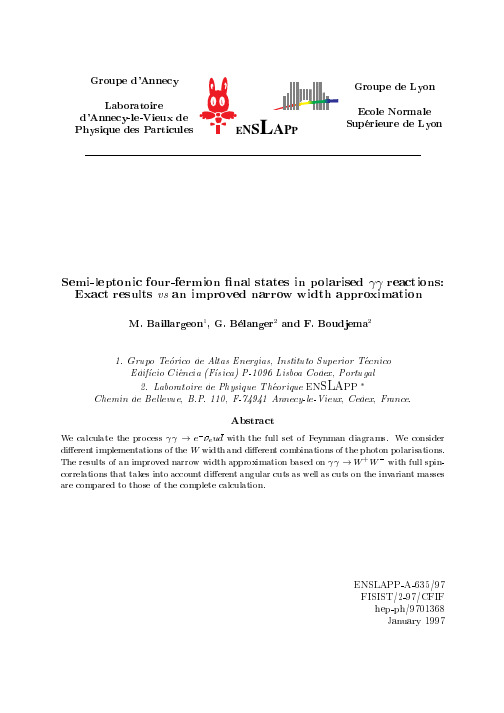
1. Grupo Teorico de Altas Energias, Instituto Superior Tecnico Edif cio Ci^ncia (F sica) P-1096 Lisboa Codex, Portugal e 2. Laboratoire de Physique Theorique ENSLAPP Chemin de Bellevue, B.P. 110, F-74941 Annecy-le-Vieux, Cedex, France.
We calculate the process ! e? e ud with the full set of Feynman diagrams. We consider di erent implementations of the W width and di erent combinations of the photon polarisations. The results of an improved narrow width approximation based on ! W +W ? with full spincorrelations that takes into account di erent angular cuts as well as cuts on the invariant masses are compared to those of the complete calculation.
Groupe d'Annecy Laboratoire d'Annecy-le-Vieux de PhysiquGroupe de Lyon
有关太阳能电池的英文PPt
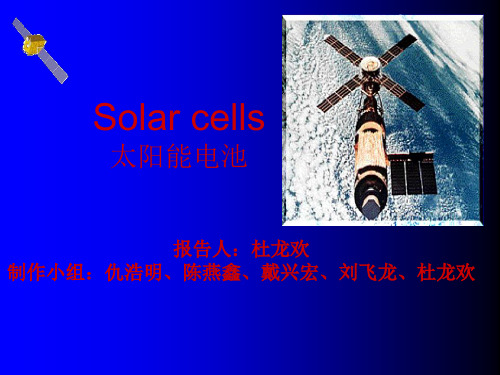
太阳能电池
报告人:杜龙欢 制作小组:仇浩明、陈燕鑫、戴兴宏、刘飞龙、杜龙欢
Working principle
Solar energy is a radiant energy, which can be converted into electrical energy by means of energy converter. The energy converter accomplishing the conversion of light energy into electrical energy is called the solar cell. Solar power in two ways, one is light - heat - electricity conversion mode, the other is light - electric direct conversion .Photovoltaic solar cells to work in crystal solar cells and thin film solar cells for the mainstream, but to work wet photochemical effects of solar cells is still in its infancy
RETURN
forum [fɔ:rəm] n. 1. 集会的公共场所 2. 论坛, 讨论会, 专题讨论节目 3. 法庭 4. 【计算机、网络】论坛 Example: Yesterday we visited the forum of ancient Romans. 昨天我们参观了古罗马的公共集会广场。 They're holding a forum on new ways of teaching history. 他们正在举行历史教学讨论会。
lbp3500维修手册

Indicates an item requiring care to avoid combustion (fire).
Indicates an item prohibiting disassembly to avoid electric shocks or problems.
1.3 Product Specifications ................................................................................................................................1- 1 1.3.1 Specifications .......................................................................................................................................................... 1- 1
1.4 Name of Parts.............................................................................................................................................1- 3 1.4.1 External View........................................................................................................................................................... 1- 3 1.4.2 Cross Section .......................................................................................................................................................... 1- 4
BellSouth 地区交换电话运营商(CLEC)更新:本地订购手册(LOH)版本24.0C、新的地
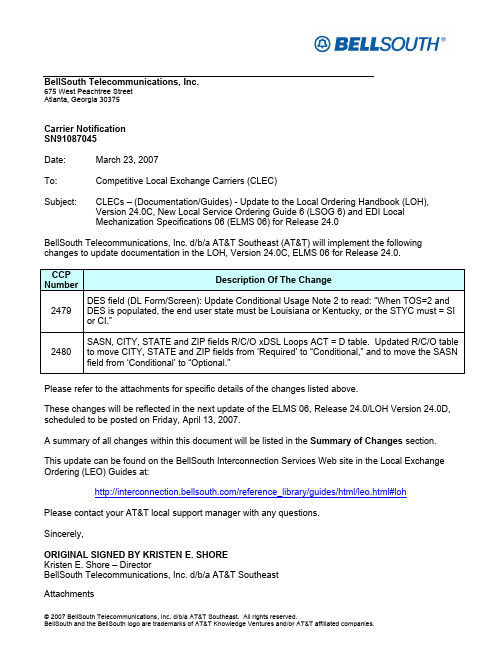
BellSouth Telecommunications, Inc.675 West Peachtree StreetAtlanta, Georgia 30375CarrierNotificationSN91087045Date: March 23, 2007To: Competitive Local Exchange Carriers (CLEC)Subject: CLECs – (Documentation/Guides) - Update to the Local Ordering Handbook (LOH), Version 24.0C, New Local Service Ordering Guide 6 (LSOG 6) and EDI LocalMechanization Specifications 06 (ELMS 06) for Release 24.0BellSouth Telecommunications, Inc. d/b/a AT&T Southeast (AT&T) will implement the following changes to update documentation in the LOH, Version 24.0C, ELMS 06 for Release 24.0.CCPNumberDescription Of The Change2479 DES field (DL Form/Screen): Update Conditional Usage Note 2 to read: “When TOS=2 and DES is populated, the end user state must be Louisiana or Kentucky, or the STYC must = SI or CI.”2480 SASN, CITY, STATE and ZIP fields R/C/O xDSL Loops ACT = D table. Updated R/C/O table to move CITY, STATE and ZIP fields from ‘Required’ to “Conditional,” and to move the SASN field from ‘Conditional’ to “Optional.”Please refer to the attachments for specific details of the changes listed above.These changes will be reflected in the next update of the ELMS 06, Release 24.0/LOH Version 24.0D, scheduled to be posted on Friday, April 13, 2007.A summary of all changes within this document will be listed in the Summary of Changes section. This update can be found on the BellSouth Interconnection Services Web site in the Local Exchange Ordering (LEO) Guides at:/reference_library/guides/html/leo.html#lohPlease contact your AT&T local support manager with any questions.Sincerely,ORIGINAL SIGNED BY KRISTEN E. SHOREKristen E. Shore – DirectorBellSouth Telecommunications, Inc. d/b/a AT&T SoutheastAttachmentsCCP 2479 Attachment Listed BelowLOH-24.0-ELMS06CRB: 5004CCP: 2479MAP: ELMS6Release: 24DL:DES fieldDESDesignationDL Form / ScreenLSOG6 / ELMS6DefinitionIndicates the professional designation phrase of a business listing.Definition NotesNote 1:Typically prints in the white pages and is used to identify the type of business when it is notinherently obvious from the name (e.g., Bob Smith and Daughters plmbr).Valid EntriesDesignation abbreviationsValid Entry NotesNote 1:Allowable values provided in yellow page header book (YPH). BAPCO-BellSouth®Advertising and Publishing Company.Data CharacteristicsUp to 25 alpha/numericExamplesattyConditional Usage NotesNote 1:Prohibited when the LACT field is Z.Note 2:Prohibited when the 1st character of the TOS is 2 and the State on the EU form is notKentucky or Lousiana and/or when the STYC is not SI or CI.When TOS=2 and DES is populated, the end user state must be Louisiana or Kentucky, or the STYC must = SI or CI.Business RulesRule 1:Designation will print in the white pages of the directory.Rule 2:Designation will print in lower case letters.Rule 3:Designation will not print, or affect placement in the yellow page section of the directory.Rule 4:Not allowed on Residence accounts except when the residence telephone number isindented in an arrangement with a business listing.* * * * * * * * * * End of definition for field DES * * * * * * * * * *CCP 2480 Attachment Listed BelowLOH-24.0-ELMS06CRB: 5005CCP: 2480MAP: ELMS6Release: 24xDSL R/C/O TablesxDSL LoopsProduct ListingxDSL LoopsThe xDSL Loops are capable loops providing a transmission path between a Collocation agreement and a customer premises, between two customer premises, or between two Collocation arrangements.Currently, three offerings are available for xDSL Loops:•2-Wire ADSL Capable Loop w/Network Interface Device (NID)•2-Wire HDSL Capable Loop w/NID•4-Wire HDSL Capable Loop w/NIDAsynchronous Digital Subscriber Line (ADSL) is a 2-wire Metallic Interface consisting of metallic facilities only. ADSL is a transport technology only and cannot be transported over Digital Loop Carrier (DLC) or interoffice facilities. High-Bit Rate Digital Subscriber Line (HDSL) is a transport technology that can either be 2-wire or 4-wire. The loop facility consists of only metallic facilities and cannot be transported over Digital Loop Carrier (DLC) or interoffice facilities.Ordering Forms/ScreensThe following chart illustrates the required, conditional and optional forms/screens for ordering this service. Detailed information will follow to assist you in filling out each of these forms/screens.Forms/ScreensxDSL LoopsSI LSR Hunting EU DL RS DRS PS NP LS LSNP RPL Proprietary R R R RR = Required C = Conditional O = OptionalService Inquiry Form InstructionsThe following two subsections provide instructions for the SI Process. The SI form is reproduced at the end of this section.SI Process for ADSL and HDSL Loops:Manual Service Inquiry Process1. CLEC will send manual SI (Service Inquiry) and LSR for ADSL or HDSL Loop setup to the UNE CRSG.2. UNE CRSG will forward the SI to OSPE.3. The completed SI and LSR will then be forwarded to the LCSC to process the service order to bill the CLEC for appropriate charges and provision the LSR.Electronic Loop Make UpThe Service Inquiry Form is not required when the CLEC uses the Electronic Loop Make Pre-order Function to qualify the loop. Refer to the BellSouth® Pre-Order Business Rules.If a new facility is being requested, the CLEC must obtain Loop Make-up (LMU) information (either manually or electronically), a Facility Reservation Number and populate the reservation number in the RESID field on the LSR.If the loop being ordered is a reuse of an existing facility and the CLEC has determined that the facility is compatible to the loop type being ordered, it is not necessary to obtain a RESID. Populate the RESID field with all "X's" and submit the electronic order.If Loop Modifications are required, a SI and LSR must be submitted manually, following the guidelines in theADSL/HDSL CLEC information Package.Service Inquiry FormNote:The Service Inquiry form is not included in this document. Contact your Local Support Manager (LSM)to obtain the form.Completing the DL Form/ScreenIf directory listings are required, refer to REQTYP J for more information on completing the DL form/screen.Completing the LSR and EU Forms/ScreensAccount level activities (ACT) apply to the entire account. A complete list of ACTs and their definition can be found in the Data Dictionary entry for ACT.The following chart shows all of the valid account level activities for this service.Valid Account Level ActivitiesxDSL LoopsN C D T R V S B W L YX X X X - X - - X - - “X” denotes valid account level activities. A dash (-) indicates a non-valid account level activity.The Required, Conditional and Optional (R/C/O) fields on the LSR and EU forms/screens will be given for every validACT code in the ACT Tables section.Completing the LS Form/ScreenThe Loop Service (LS) form/screen may be required or invalid depending on the account level activity. Each accountlevel activity has valid Line Level Activities (LNAs). These LNAs determine how, or if, the LS form/screen should bepopulated. A complete list of LNAs and their definition can be found in the Data Dictionary entry for LNA.The following chart gives the valid LNAs for each account level activity (ACT) and the associated LS form/screenusage for this service.If ACT is: Then LNA is: And LS form/screen is:N N RequiredC N &D for electronic orders; C for manual orders RequiredD D RequiredT N or T RequiredV N, V or D RequiredW W Required The Required, Conditional and Optional (R/C/O) fields for the Loop Service (LS) form/screen are listed according tothe Line Level Activity (LNA) in the LNA Tables Section.RCO TablesThe following tables show the Required, Conditional and Optional (R/C/O) fields on the validforms/screens for this product. All unmentioned fields are either invalid, not applicable, prohibited or not supported. When fields are populated which are not supported by BellSouth, these not supported fields will be ignored. Populating any other fields may result in a fatal reject or a clarification of the service request. Please note the following codes:- Optional fields marked with an asterisk (*) force at least one of the conditional fields to become required when populated.- Fields used only for manual orders are followed by (M).- Fields used only for electronic orders are followed by (E).- For fields marked with a DOUBLE asterisk (**) please refer to the Data Dictionary for clarification. See the Data Dictionary Section for additional information on each field.ACT= D: LSRRequiredACNA ACT ACTLAN BAN1CCCCNA D/TSENT DDDIMPCON IMPCON-TEL NO.INITINIT-FAX NO.INIT-TEL NO.NCNCI PG_OF_ (M)PONREQTYP SC SECNCITOSConditionalCUST LSO (E)NORPROJECT PROJINDR RCC (E)RPON SUP VEROptionalCIC REMARKS RORD (M)SN91087045 ACT Tables: Reqtyp A, xDSL LoopsACT= D: EURequiredAN (M)CITY NAMEPG_OF_ (M)PON (M)SASNSTATE ZIPConditionalAAI LD1LD2LD3LV1LV2LV3SANO SASDSASF SASS SATHVER (M)CITY STATEZIPOptionalLCON-NAME LCON-TEL NO.SASN*。
event
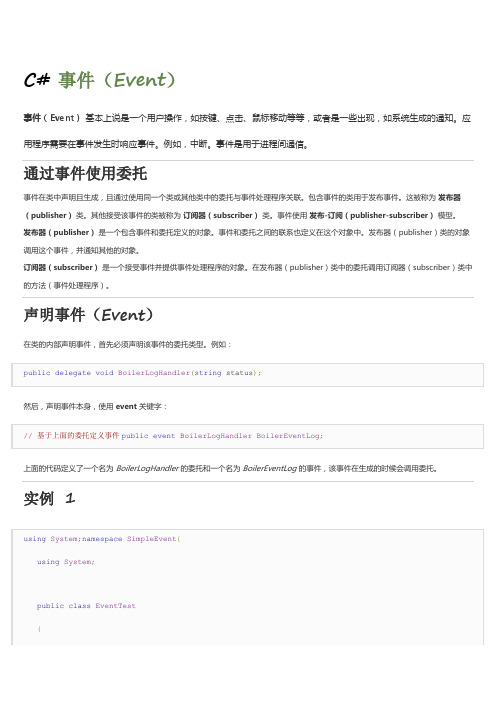
C# 事件(Event)事件(Event)基本上说是一个用户操作,如按键、点击、鼠标移动等等,或者是一些出现,如系统生成的通知。
应用程序需要在事件发生时响应事件。
例如,中断。
事件是用于进程间通信。
通过事件使用委托事件在类中声明且生成,且通过使用同一个类或其他类中的委托与事件处理程序关联。
包含事件的类用于发布事件。
这被称为发布器(publisher)类。
其他接受该事件的类被称为订阅器(subscriber)类。
事件使用发布-订阅(publisher-subscriber)模型。
发布器(publisher)是一个包含事件和委托定义的对象。
事件和委托之间的联系也定义在这个对象中。
发布器(publisher)类的对象调用这个事件,并通知其他的对象。
订阅器(subscriber)是一个接受事件并提供事件处理程序的对象。
在发布器(publisher)类中的委托调用订阅器(subscriber)类中的方法(事件处理程序)。
声明事件(Event)在类的内部声明事件,首先必须声明该事件的委托类型。
例如:public delegate void BoilerLogHandler(string status);然后,声明事件本身,使用event关键字:// 基于上面的委托定义事件public event BoilerLogHandler BoilerEventLog;上面的代码定义了一个名为BoilerLogHandler的委托和一个名为BoilerEventLog的事件,该事件在生成的时候会调用委托。
实例 1using System;namespace SimpleEvent{using System;public class EventTest{private int value;public delegate void NumManipulationHandler(); public event NumManipulationHandler ChangeNum;protected virtual void OnNumChanged(){if(ChangeNum!=null){ChangeNum();}else{Console.WriteLine("Event fired!");}}public EventTest(int n ){SetValue(n);}public void SetValue(int n){if(value != n){value = n;OnNumChanged();}}}public class MainClass{public static void Main(){EventTest e =new EventTest(5);e.SetValue(7);e.SetValue(11);Console.ReadKey();}}}当上面的代码被编译和执行时,它会产生下列结果:Event Fired!Event Fired!Event Fired!实例 2本实例提供一个简单的用于热水锅炉系统故障排除的应用程序。
超通TC6215高电压低阈值双通道MOSFET说明书
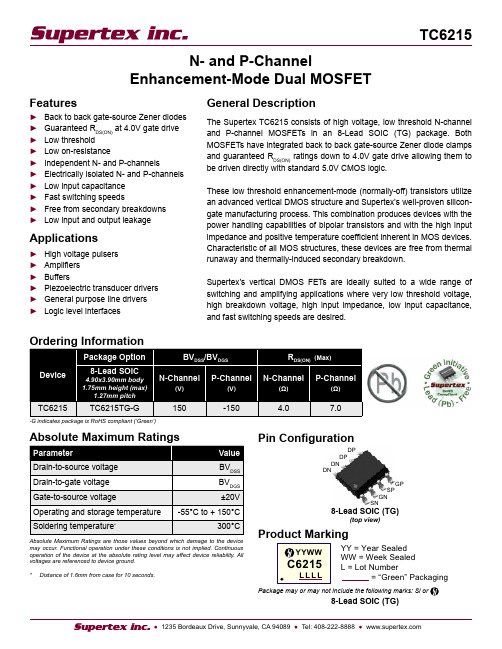
FeaturesBack to back gate-source Zener diodes Guaranteed R DS(ON) at 4.0V gate drive Low threshold Low on-resistanceIndependent N- and P-channelsElectrically isolated N- and P-channels Low input capacitance Fast switching speedsFree from secondary breakdowns Low input and output leakageApplicationsHigh voltage pulsers Amplifiers BuffersPiezoelectric transducer drivers General purpose line drivers Logic level interfaces►►►►►►►►►►►►►►►►General DescriptionThe Supertex TC6215 consists of high voltage, low threshold N-channel and P-channel MOSFETs in an 8-Lead SOIC (TG) package. Both MOSFETs have integrated back to back gate-source Zener diode clamps and guaranteed R DS(ON) ratings down to 4.0V gate drive allowing them to be driven directly with standard 5.0V CMOS logic.These low threshold enhancement-mode (normally-off) transistors utilize an advanced vertical DMOS structure and Supertex’s well-proven silicon-gate manufacturing process. This combination produces devices with the power handling capabilities of bipolar transistors and with the high input impedance and positive temperature coefficient inherent in MOS devices. Characteristic of all MOS structures, these devices are free from thermal runaway and thermally-induced secondary breakdown.Supertex’s vertical DMOS FETs are ideally suitedto a wide range of switching and amplifying applications where very low threshold voltage, high breakdown voltage, high input impedance, low input capacitance, and fast switching speeds are desired.N- and P-ChannelEnhancement-Mode Dual MOSFET-G indicates package is RoHS compliant (‘Green’)GP SP GN SNDP DP DN DNYY = Year Sealed WW = Week Sealed L = Lot Number= “Green” Packaging 8-Lead SOIC (TG)(top view)Absolute Maximum Ratings are those values beyond which damage to the device may occur. Functional operation under these conditions is not implied. Continuous operation of the device at the absolute rating level may affect device reliability. All voltages are referenced to device ground.* Distance of 1.6mm from case for 10 seconds.8-Lead SOIC (TG)Package may or may not include the following marks: Si orPin ConfigurationN-Channel Switching Waveforms and Test CircuitVOUTPUT 10V0V0VVDDInputOutputNotes:All DC parameters 100% tested at 25°C unless otherwise stated. (Pulsed test: 300µs pulse at 2% duty cycle.)All AC parameters sample tested.1.2.DD0V -10V0V V DDInputOutputNotes:All DC parameters 100% tested at 25°C unless otherwise stated. (Pulsed test: 300µs pulse at 2% duty cycle.)All AC parameters sample tested.1.2.Block DiagramSN GN SPGPDPDPDN DN 8-Lead SOIC(top view)P-Channel Output Characteristics-4.0-3.5-3.0-2.5-2.0-1.5-1.0-0.50.0-50-45-40-35-30-25-20-15-10-5V DS (volts)I D (a m p e r e s )V =-10VV =-8V V =-7VV =-6VV =-5VV =-4VV =-3VV =-2VP-Channel Saturation Characteristics-2.2-2.0-1.8-1.6-1.4-1.2-1.0-0.8-0.6-0.4-0.20.0-10-9-8-7-6-5-4-3-2-1V DS (volts)I D (a m p e r e s )V GS =-10V V GS =-8V V GS =-6V V GS =-5VV GS =-4VV GS =-3VV GS =-2VN-Channel Output Characteristics0.00.51.01.52.02.53.03.54.04.505101520253035404550V DS (volts)I D (a m p e r e s )V GS =10V V GS =8V V GS =7VV GS =6VV GS =5VV GS =4VV GS =3VV GS =2VN-Channel Saturation Characteristics0.00.51.01.52.02.53.03.54.012345678910V DS (volts)I D (a m p e r e s )V GS =10V V GS =8V V GS =6VV GS =5VV GS =4VV GS =3VV GS =2VTypical Performance CurvesSupertex inc. does not recommend the use of its products in life support applications, and will not knowingly sell them for use in such applications unless it receives an adequate “product liability indemnification insurance agreement.” Supertex inc. does not assume responsibility for use of devices described, and limits its liability to the replacement of the devices determined defective due to workmanship. No responsibility is assumed for possible omissions and inaccuracies. Circuitry and specifications are subject to change without notice. For the latest product specifications refer to the Supertex inc. website: http//.©2008 All rights reserved. Unauthorized use or reproduction is prohibited.1235 Bordeaux Drive, Sunnyvale, CA 94089(The package drawing(s) in this data sheet may not reflect the most current specifications. For the latest package outline information go to /packaging.html .)8-Lead SOIC (Narrow Body) Package Outline (TG)4.90x3.90mm body, 1.75mm height (max), 1.27mm pitchSide ViewView A-AJEDEC Registration MS-012, Variation AA, Issue E, Sept. 2005.* This dimension is not specified in the original JEDEC drawing. The value listed is for reference only.Drawings are not to scale.Supertex Doc. #: DSPD-8SOLGTG, Version H101708.Note:This chamfer feature is optional. A Pin 1 identifier must be located in the index area indicated. The Pin 1 identifier can be: a molded mark/identifier;an embedded metal marker; or a printed indicator.1.。
Unit 2 Energy in Transition (补充汉译英)

Unit 2 Energy in Transition ( 补充汉译英 )1.汉普顿-悉尼学院以其诚信制度与其军事化管理体系一样儿享有盛名。
而且此诚信制度扩展到学生在校内和校外的所有活动中。
并且认为对违规行为的包容本身就是一种违规行为。
( on a par with )Hampden-Sydney College is reputed for an honor system on a par with military systems, and this honor system extends to all student activities both on and off campus, and considers tolerance of a violation itself a violation.2.虽然全球变暖对地球构成威胁,但是人类或许可以通过提高大气层中二氧化碳含量(值)来缓和其所导致的气候威胁。
( pose a threat on sth/sb. )Although global warming poses a threat to the earth, humans can probably ease the climate threat brought on by rising levels of carbon dioxide in the atmosphere.3.对于厄尔尼诺潜在的破坏性人们已了解许多,但其现象本身却仍是令人沮丧的费解之谜。
( enough is known about sth )Enough is known about Elnino’s destructive potential, but the phenomenon itself remains a frustrating mystery.4.中国就生态和环保已形成全社会共识并正在率先行动起来。
001 (ISSCC tutorial)Noise Analysis in Switched-Capacitor Circuits

© 2011 IEEE
IEEE International Solid-State Circuits Conference
© 2011 IEEE
Thermal Noise Power
• Nyquist showed that
PSD ( f ) = 4kT
• The total average noise power of a resistor in a certain frequency band is therefore
– Examples: Audio systems, wireless transceivers, sensor interfaces
• Electronic noise directly trades with power dissipation and speed • Electronic noise is a major concern in modern technologies with reduced VDD
• The noise of a MOSFET operating in the triode region is approximately equal to that of a resistor • In the saturation region, the thermal noise can be modeled using a drain current source with power spectral density
• We can model the noise using an equivalent voltage or current generator
2 vn
= Pn ⋅ R = 4kT ⋅ R ⋅ Δf
Adaptive cooperative tracking control of higher-order nonlinear systems with
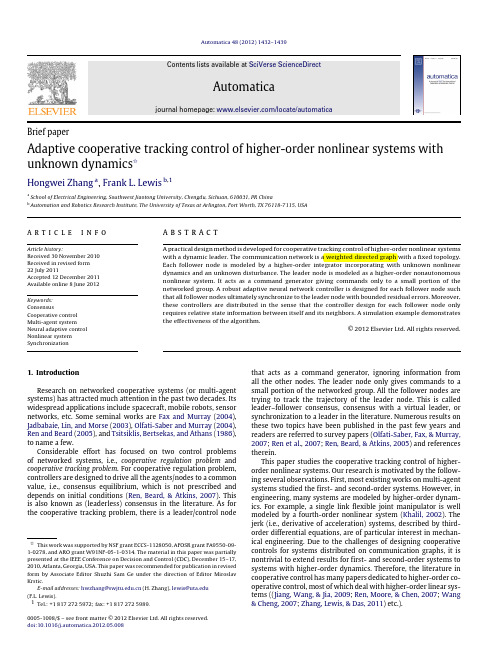
Contents lists available at SciVerse ScienceDirect
Automatica
journal homepage: /locate/automatica
Brief paper
Article history: Received 30 November 2010 Received in revised form 22 July 2011 Accepted 12 December 2011 Available online 8 June 2012 Keywords: Consensus Cooperative control Multi-agent system Neural adaptive control Nonlinear system Synchronization
✩ This work was supported by NSF grant ECCS-1128050, AFOSR grant FA9550-091-0278, and ARO grant W91NF-05-1-0314. The material in this paper was partially presented at the IEEE Conference on Decision and Control (CDC), December 15–17, 2010, Atlanta, Georgia, USA. This paper was recommended for publication in revised form by Associate Editor Shuzhi Sam Ge under the direction of Editor Miroslav Krstic. E-mail addresses: hwzhang@ (H. Zhang), lewis@ (F.L. Lewis). 1 Tel.: +1 817 272 5972; fax: +1 817 272 5989.
Romeo Ortega

L 2 L 1x ? 1 x x2 = (1 ? v) C 1 RC 2 _
1
1 for tk t < tk + (tk )T 0 for tk + (tk )T t < tk + T where tk represents a sampling instant de ned by tk+1 = tk + T; k = 0; 1; : : :,; the parameter T > 0 is the xed sampling period, also called the duty cycle. The duty ratio function, ( ), ranging on the closed interval 0; 1], is the control input to the average PWM model given by 13] z_ = ?u 1 z + E + !
where x1 and x2 represent, respectively, the input inductor current and the output capacitor voltage variables; E > 0 represents the nominal constant value of the external voltage source and ! is an unknown disturbance, which satis es j! j < E ; v , which takes values in the discrete set f0; 1g, denotes the switch position function, and acts as a control input. The regulated output is x2 which should be driven to some constant desired value Eo > E . A Pulse Width Modulation (PWM) policy regulating the switch position function v , may 2
Applied Energy

逄秀锋,等:我国建筑调适发展现状与前景指南与标准、建立激励机制以及政策法规、走向市场化产业化。
我国建筑调适的发展目前也遵循了这样一条发展路径,不同的是,我们的目标是用更短的时间完成西方国家四十多年走过的道路。
参考文献:[1]Mills E.Commissioning Capturing the Potential[J].ASHRAE Journal,2011,53(2):1-2.[2]逄秀锋,刘珊,曹勇.建筑设备与系统调适[M].北京:中国建筑工业出版社,2015:1-2.[3]Legris C,Choiniere D,Milesi Ferretti.Annex47Report1:Commissioning Overview[R].Paris:International Energy Agency,2010.[4]The U.S.Department of Energy.New DOE Research Strengthens Business Case for Building Commissioning[EB/OL].(2019-05-02)[2020-01-02].https://www.energy.gov/eere/buildings/articles/ new-doe-research-strengthens-business-case-building-commissioning.作者简介:逄秀锋(1976),男,辽宁人,毕业于美国内布拉斯加大学林肯分校,暖通空调专业,博士,研究员,研究方向:建筑调适技术、建筑系统能耗模拟、暖通空调系统故障诊断与优化控制、智慧建筑(xpang113@163.com)。
Energy and Buildingshttps://www.sciencedirect.com/journal/energy-and-buildings/vol/224/suppl/CVolume224,1October2020(1)A new analytical model for short-time analysis of energypiles and its application,by Jian Lan,Fei Lei,Pingfang Hu,Na Zhu,Article110221Abstract:An energy pile is a special form of vertical ground heatexchanger that couples the roles of structural support and heat trans-fer.Modeling the transient heat transfer process inside an energy pilehas importance;however,available analytical models either have in-sufficient calculation accuracy or are computationally demanding.Based on three existing models,this paper proposes a novel short-term hybrid composite-medium line-source(HCMLS)model,whichis not only efficient in computation but also more accurate than mosttraditional analytical models.The model is suitable for ground heatexchangers of various radii.Comparisons between the hybrid analyti-cal model and a numerical model are made for energy pile cases withdifferent parameters,including the thermal properties,borehole radii,relative positions of tubes,and number of tubes.In general,the hy-brid composite-medium line-source model gives credible predictionafter100min.The new model is further validated by the infinitecomposite-medium line-source(ICMLS)model,which is currentlythe most theoretically complete short-term model.Moreover,the newmodel is applied to thermal response tests(TRTs).The least dimen-sionless test duration for interpretations based on the modified hybridcomposite-medium line-source(C-HCMLS)solution is Fo>1.7.This study renders the application of in situ TRTs to energy pileswith large diameters feasible.Keywords:Ground heat exchanger;Energy pile;Short time re-sponse;Thermal response testing(2)Charging performance of latent thermal energy storage sys-tem with microencapsulated phase-change material for domestichot water,by Y.Fang,Z.G.Qu,J.F.Zhang,H.T.Xu,G.L.Qi,Arti-cle110237(3)Thermographic2D U-value map for quantifying thermalbridges in building fa ades,by Blanca Tejedor,Eva Barreira,Ricardo M.S.F.Almeida,Miquel Casals,Article110176(4)Urban morphology and building heating energy con-sumption:Evidence from Harbin,a severe cold region city,by Hong Leng,Xi Chen,Yanhong Ma,Nyuk Hien Wong,Tingzhen Ming,Article110143(5)UK Passivhaus and the energy performance gap,by Ra-chel Mitchell,Sukumar Natarajan,Article110240Building and Environmenthttps://www.sciencedirect.com/journal/building-and-environ-ment/vol/183/suppl/CVolume183,October2020(1)Residential buildings airtightness frameworks:A reviewon the main databases and setups in Europe and NorthAmerica,by Irene Poza-Casado,Vitor E.M.Cardoso,Ricar-do M.S.F.Almeida,et al,Article107221Abstract:The airtightness of buildings has gained relevance in thelast decade.The spread of the regulatory frameworks,the demand ofstricter requirements,schemes for testing and quality control,the cre-ation of airtightness databases and its analysis,is proof of this real-ity.The present review encompasses schemes developed in Europeand North America with regard to these aspects for national residen-tial sectors.A normative framework on requirements and recommen-dations at the national level is compiled.Whole building airtightnessdatabases are compared based on their structures and measurementdata acquisition protocols.Gathered complementary information notdirectly related to testing is analysed and airtightness influencing fac-tors importance and relationships are discussed.Weaknesses andstrengths in the different aspects of the existing database setups areidentified.Also,neglected or not entirely undertaken topics are pin-pointed together with the suggestion of possible opportunities forfuture works and changes.Amongst other relevant remarks and dis-cussions,it is concluded that the lack of uniformization in methodbetween countries,the need for a minimum data setup,the lack ofdata analysis on relating the energy impact with the advancement inrequirements of airtightness performance and the implemented setupsare some of the main issues to address in the near future.Keywords:Review paper;Airtightness;Regulation policy(2)A simulation framework for predicting occupant thermalsensation in perimeter zones of buildings considering directsolar radiation and ankle draft,by Shengbo Zhang,Jamie P.Fine,Marianne F.Touchie,William O’Brien,Article107096(3)Comparative review of occupant-related energy aspectsof the National Building Code of Canada,by Ahmed Abdeen,William O’Brien,Burak Gunay,Guy Newsham,HeatherKnudsen,Article107136Applied Energyhttps://www.sciencedirect.com/journal/applied-energy/vol/275/suppl/CVolume275,1October2020(1)Performance characteristics of variable conductance loopthermosyphon for energy-efficient building thermal control,byJingyu Cao,Xiaoqiang Hong,Zhanying Zheng,et al,Article115337Abstract:Variable conductance loop thermosyphon(VCLT)manip-ulates natural phase-change cycle to regulate the heat transfer.Its pri-mary advantages include high sustainability,simple design and lowcost.One of the potential applications of variable conductance loopthermosyphon is thermal control in buildings for achieving highenergy efficiency.In this study,a distributed steady-state model wasimplemented to determine the heat transfer control characteristics ofvariable conductance loop thermosyphon for the first time and evalu-ate its effectiveness on precise air-conditioning for buildings.The in-ternal flow resistance rises from0.002K/W to0.305K/W and theheat transfer rate decreases from468.5W to71.9W when the rela-tive opening degree of the regulating valve reduces from1.00to0.17under normal boundary conditions.The thermodynamic analysesshow that the regulating valve of the variable conductance loop ther-mosyphon can enable effective thermal control over a wide range ofheat transfer rate to accomplish indoor thermal comfort.The studyalso reveals that variable conductance loop thermosyphon can be ef-fectively adopted with various working fluids and over wide rangesof heat source and heat sink temperatures.Keywords:Air-conditioning;Energy-efficient building;Loop ther-mosyphon;Numerical study(2)Increasing the energy flexibility of existing district heatingnetworks through flow rate variations,by Jacopo Vivian,Dav-ide Quaggiotto,Angelo Zarrella,Article115411(3)A framework for uncertainty quantification in buildingheat demand simulations using reduced-order grey-box en-ergy models,by Mohammad Haris Shamsi,Usman Ali,EleniMangina,James O’Donnell,Article115141(2020-10-10《建筑节能》杂志社侯恩哲摘录)7。
CEI IEC 61508 6

Annex B (informative) Example technique for evaluating probabilities of failure .................................21 B.1 B.2 General........................................................................................................................21 Average probability of failure per demand (for low demand mode of operation) .....................23 B.2.1 B.2.2 B.2.3 B.2.4 B.3 Procedure for calculations..................................................................................23 Detailed tables for low demand mode of operation ................................................26 Examples for low demand mode of operation .......................................................30 Architectures for low demand mode of operation ..................................................33
高考英语一轮复习 人教 必修2 Book 2- Unit4 Wildlife Protection重点词汇复习
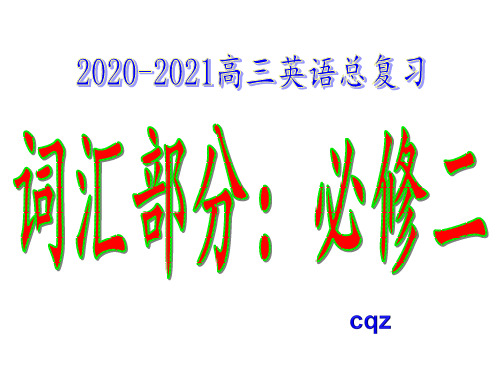
mmoossqquuiittoo n..
蚊子
iinnsseecctt n.
昆虫
ccoonnttaaiinn vvtt.
包包含含;;容容纳纳;;容容忍忍
powerful adj.
强大的;有力的
affect vt.
影响;感动;侵袭
attention n.
注意;关注;注意力
pay attention to
_t_o__fi_n_d_(find) out more about it for myself.
9. loss n. 损失;遗失;丧失 lose v. lost /lost 【固定搭配】
make up (for) a loss弥补损失 at a loss不知所措;亏本地 【语法填空】 ①He moved to another job;it is a great _lo_s_s__(lose) to our firm. ②He was __a_t __ a loss what to do. ③He sold his house at _a___ loss. 10. reserve n. 保护区
6. decrease vi. & vt 减少; (使)变小;或变少 increase v.(使)增长,增多;增加 n.增长;增多;增加
【固定搭配】 decrease / increase by减少了/增加了 decrease / increase (from…) to(从…)减少到/增加到 an increase / decrease of 增加/减少 【语法填空】 ①Average house prices decreased _b_y_13% last month. ②The number of new students decreased from 2100 _t_o__
稀疏恢复和傅里叶采样
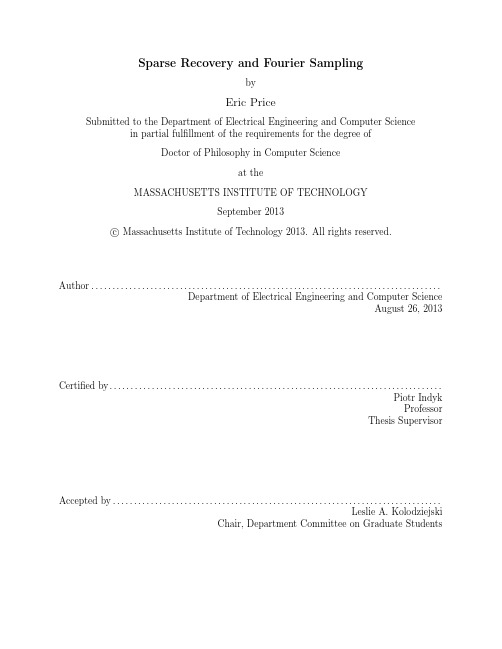
Accepted by . . . . . . . . . . . . . . . . . . . . . . . . . . . . . . . . . . . . . . . . . . . . . . . . . . . . . . . . . . . . . . . . . . . . . . . . . . . . . . Leslie A. Kolodziejski Chair, Department Committee on Graduate Students
2
Sparse Recovery and Fourier Sampling by Eric Price
Submitted to the Department of Electrical Engineering and Computer Science on August 26, 2013, in partial fulfillment of the requirements for the degree of Doctor of Philosophy in Computer Science
Author . . . . . . . . . . . . . . . . . . . . . . . . . . . . . . . . . . . . . . . . . . . . . . . . . . . . . . . . . . . . . . . . . . . . . . . . . . . . . . . . . . . Department of Electrical Engineering and Computer Science August 26, 2013
Certified by . . . . . . . . . . . . . . . . . . . . . . . . . . . . . . . . . . . . . . . . . . . . . . . . . . . . . . . . . . . . . . . . . . . . . . . . . . . . . . . Piotr Indyk Professor Thesis Supervisor
新GRE阅读真题与解析(维C上校 编著)

新GRE阅读真题&解析维C上校·编著【Preface写在前面】发现,在那些日子里,自己做了很多让自己想吐的事情...----那个,还在学校的冬季,和金哥每天早上六七点,穿着羽绒服在操场上早读一个多小时直到要吐;当年备考GRE的时候,每天五点起来,单词一直背到晚上,直到想吐的时候,很多个夜晚,做实验做得太晚,晚上回来,宿舍锁门,不得不从楼梯的阳台翻上宿舍。
晚上健身跑步的时候,跑几公里,直到想吐的时候;在琴房练琴,练到想吐的时候。
我清楚无论怎么练,自己这辈子都不会成为一个伟大的钢琴家,但我知道,无论做什么,是可以活在那种精神里的。
无论在做什么,我都会提醒自己,是在练琴。
日子久了,慢慢懂得,生命里,快乐是一种能力。
很多事,有些人就有能力把那些大多数人感到痛苦、煎熬的事情,做得津津有味,乐在其中。
每一件事,似乎都有它本身的快乐点,于是,似乎我们在这一路的备考过程中,得去快乐去备考。
永远不要轻易的去和别人比较考试后的结果,分数。
而是努力的学会去让这个自己已经选择的路上,更加的快乐,无论是和自己的过去相比,还是和别人相比,那么我愿意相信,最终的某天,暮然回首,你会看到属于你自己的,幸福的泪水。
当年备考GRE的时候,我很想一份这样的阅读资料,可是发现一直没有发现,有些有吧,可是偏偏打上那些irritating的水印!!!讨厌!!于是,我萌生了自己去弄的念头,而且绝无任何水印的痕迹(如果某天你发现有的话,肯定是出问题了。
要么是你有问题,要么是我出问题了,哈哈哈。
)。
于是,你现在看到的这份资料。
如今,暮然回首,一直很想为那些还在追梦,考G的你们做点事情--因为我曾经也走过这条路。
希望可以能为你们做点事情。
在此,祝你们备考快乐,我相信,你会的。
2013·夏季维C上校维多利·广州目录:Part1新GRE OG阅读部分 (3)Part2新GRE Practice book阅读部分 (36)Part3新GRE PP II阅读部分 (55)Part4新GRE阅读解析 (72)【注】由于ppII中,第二部分的内容会取决于你做第一部分的正确率,于是大家的第二部分的内容可能不同。
半导体专业词汇--汇总
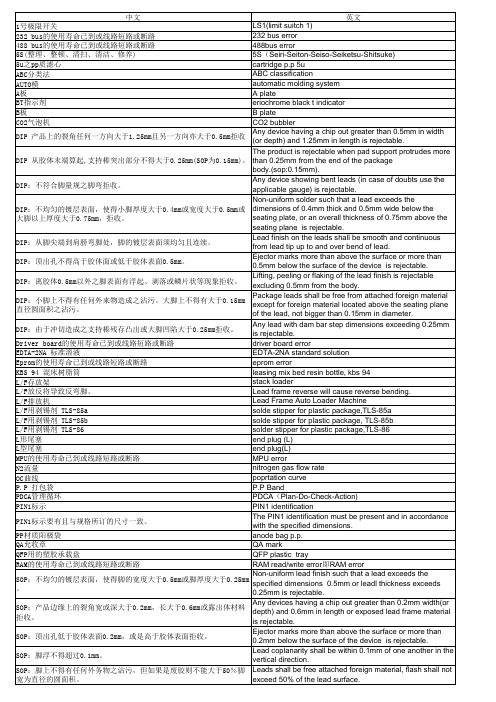
Lifting, peeling or flaking of the lead finish is rejectable excluding 0.2mm of the lead length from body. Any lead with dam bar step dimensions exceeding 0.1mm is rejectable. end plug (S) manager of XX department XX Electronics CO.Ltd X-ray yield X-ray X-ray inspection safety curtain safety stock safety glasses ammoniam water Press the emergency button. lot for lot lifted bond lifted wedge cavity plate,cavity block PPM (parts per million) Pareto chart plate mold semiconductor insufficient ball size off loader wrong orentation molding wrong orientation molding molding molding mold chase mold chase molding mismatch packing packing packing box packing defect criteria shipping box carrying cost carrying cost rate safety time holdup time shelf life scrap remark backside metal (Au/Ag) back side back marking chip package chips specific gravity specific gravity hydrometer closed loop MRP closing time bending side rail edge die reject die around slice edge side rail edge die Tape & Reel tape/real peel back force test braid flat cable,ribbon cable flat ball variation discoloration discolor(yellowish,blcken,water mark) discoloration/oxidation/lifting deformed
Stata 软件中的 forvalues 命令说明说明书
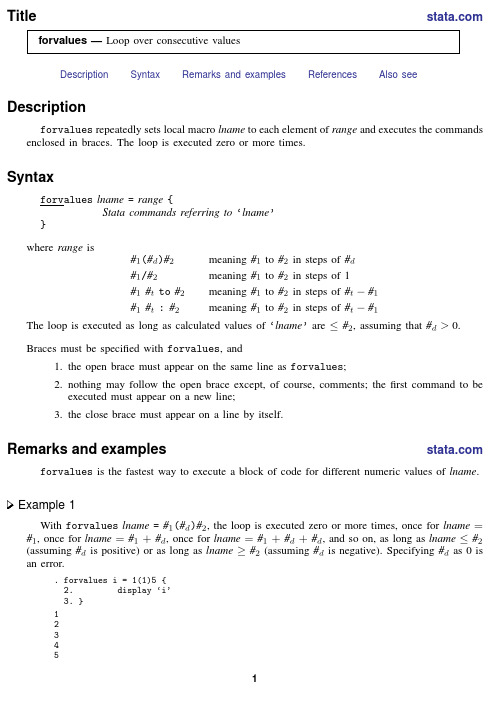
Title forvalues—Loop over consecutive valuesDescription Syntax Remarks and examples References Also seeDescriptionforvalues repeatedly sets local macro lname to each element of range and executes the commands enclosed in braces.The loop is executed zero or more times.Syntaxforvalues lname=range{Stata commands referring to‘lname’}where range is#1(#d)#2meaning#1to#2in steps of#d#1/#2meaning#1to#2in steps of1#1#t to#2meaning#1to#2in steps of#t−#1#1#t:#2meaning#1to#2in steps of#t−#1The loop is executed as long as calculated values of‘lname’are≤#2,assuming that#d>0.Braces must be specified with forvalues,and1.the open brace must appear on the same line as forvalues;2.nothing may follow the open brace except,of course,comments;thefirst command to beexecuted must appear on a new line;3.the close brace must appear on a line by itself.Remarks and examples forvalues is the fastest way to execute a block of code for different numeric values of lname. Example1With forvalues lname=#1(#d)#2,the loop is executed zero or more times,once for lname= #1,once for lname=#1+#d,once for lname=#1+#d+#d,and so on,as long as lname≤#2 (assuming#d is positive)or as long as lname≥#2(assuming#d is negative).Specifying#d as0is an error..forvalues i=1(1)5{2.display‘i’3.}1234512forvalues—Loop over consecutive valueslists the numbers1–5,stepping by1,whereas.forvalues i=10(-2)1{2.display‘i’3.}108642lists the numbers starting from10,stepping down by2until it reaches2.It stops at2instead of at 1or0..forvalues i=1(1)1{2.display‘i’3.}1displays1,whereas.forvalues i=1(1)0{2.display‘i’3.}displays nothing.forvalues lname=#1/#2is the same as using forvalues lname=#1(1)#ing/does not allow counting backward.Example2.forvalues i=1/3{2.display‘i’3.}123lists the three values from1to3,but.forvalues i=3/1{2.display‘i’3.}lists nothing because using this form of the forvalues command allows incrementing only by1.The forvalues lname=#1#t to#2and forvalues lname=#1#t:#2forms of the forvalues command are equivalent to computing#d=#t−#1and then using the forvalues lname=#1(#d)#2 form of the command.forvalues—Loop over consecutive values3 Example3.forvalues i=510:25{2.display‘i’3.}510152025.forvalues i=2520to5{2.display‘i’3.}252015105T echnical noteIt is not legal syntax to type.scalar x=3.forvalues i=1(1)‘x’{2.local x=‘x’+13.display‘i’4.}forvalues requires literal ing macros,as shown in the following technical note,is allowed.T echnical noteThe values of the loop bounds are determined once and for all thefirst time the loop is executed. Changing the loop bounds will have no effect.For instance,.local n3.forvalues i=1(1)‘n’{2.local n=‘n’+13.display‘i’4.}123will not create an infinite loop.With‘n’originally equal to3,the loop will be performed three times.4forvalues—Loop over consecutive valuesSimilarly,modifying the loop counter will not affect forvalues’subsequent behavior.For instance, .forvalues i=1(1)3{2.display"Top of loop i=‘i’"3.local i=‘i’*44.display"After change i=‘i’"5.}Top of loop i=1After change i=4Top of loop i=2After change i=8Top of loop i=3After change i=12will still execute three times,setting‘i’to1,2,and3at the beginning of each iteration.ReferencesCox,N.J.2010.Stata tip85:Looping over nonintegers.Stata Journal10:160–163..2020.Speaking Stata:Loops,again and again.Stata Journal20:999–1015..2021a.Erratum:Speaking Stata:Loops,again and again.Stata Journal21:555..2021b.Speaking Stata:Loops in parallel.Stata Journal21:1047–1064.Drukker,D.M.2015.Monte Carlo simulations using Stata.The Stata Blog:Not Elsewhere Classified./2015/10/06/monte-carlo-simulations-using-stata/.Huber,C.2014.How to create animated graphics using Stata.The Stata Blog:Not Elsewhere Classified./2014/03/24/how-to-create-animated-graphics-using-stata/.Also see[P]continue—Break out of loops[P]foreach—Loop over items[P]if—if programming command[P]while—Looping[U]18Programming Stata[U]18.3MacrosStata,Stata Press,and Mata are registered trademarks of StataCorp LLC.Stata andStata Press are registered trademarks with the World Intellectual Property Organization®of the United Nations.Other brand and product names are registered trademarks ortrademarks of their respective companies.Copyright c 1985–2023StataCorp LLC,College Station,TX,USA.All rights reserved.。
- 1、下载文档前请自行甄别文档内容的完整性,平台不提供额外的编辑、内容补充、找答案等附加服务。
- 2、"仅部分预览"的文档,不可在线预览部分如存在完整性等问题,可反馈申请退款(可完整预览的文档不适用该条件!)。
- 3、如文档侵犯您的权益,请联系客服反馈,我们会尽快为您处理(人工客服工作时间:9:00-18:30)。
a rXiv:h ep-th/9811224v314J a n1999NUB–3192hep-th/9811224Remarks on Two-Loop Free Energy in N =4Supersymmetric Yang-Mills Theory at Finite Temperature ⋆A.Fotopoulos and T.R.Taylor Department of Physics,Northeastern University,Boston,MA 02115,U.S.A.Abstract The strong coupling behavior of finite temperature free energy in N =4supersym-metric SU (N )Yang-Mills theory has been recently discussed by Gubser,Klebanov and Tseytlin in the context of AdS-SYM correspondence.In this note,we focus on the weak coupling behavior.As a result of a two-loop computation we obtain,in the large N ’t Hooft limit,F (g 2N →0)≈−π22π2g 2N ).Comparison with the strong coupling expansion provides further indication that free energy is a smooth monotonic function of the coupling constant.Finite temperature effects break supersymmetry[1].By switching on non-zero temper-ature one can interpolate between supersymmetric and non-supersymmetric theories.For instance in gauge theories,one can interpolate between the supersymmetric case and a theory which contains pure Yang-Mills(YM)as the massless sector,with some additional thermal excitations.In the infinite temperature limit,the time dimension decouples and, at least formally,one obtains a non-supersymmetric Euclidean gauge theory.If no phase transition occurs when the YM gas is heated up,then the dynamics of realistic gauge theories such as QCD is smoothly connected to their supersymmetric relatives.Maldacena conjecture[2]which relates the large N limit of N=4supersymmetric SU(N)Yang Mills theory(SYM)to type IIB superstrings propagating on AdS5×S5, provides a very promising starting point towards QCD.On the superstring side,non-zero temperature can be simulated by including Schwarzschild black holes embedded in AdS spacetime[3],which describe the near-horizon geometry of non-extremal D-brane solutions [4].The classical geometry of black holes with Hawking temperature T does indeed encode correctly many qualitative features of large N gauge theory heated up to the same tem-perature.At the quantative level though,the comparison between SYM and supergravity becomes rather subtle because the supergravity side merely provides the strong coupling expansion for physical quantities while most offinite temperature computations in SYM are limited to the perturbative,weak coupling expansion.In this note,we comment on the computation of free energy.The SYM thermodynamics wasfirst compared with the thermodynamics of D-branes in ref.[5].The free energy F obtained in ref.[5]describes the limit of infinitely strong coupled SYM theory.More recently,the AdS-SYM correspondence has been employed for computing the subleading term in the strong coupling expansion(inλ≡g2N)[6,7]:1F(λ→∞)≈−π24+451In this context,the gauge coupling g is related to the type IIB superstring coupling g s:g2=2πg s.The comparison with the limiting free-theory value,F(λ=0)=−π26N2V3T4f(λ),(3) where the function f(λ)interpolates smoothly between the asymptotic values f(0)=1and f(∞)=3/4[5].The sign of the subleading correction O[(2λ)−3/2]in eq.(1)indicates that f decreases monotonically from1to3/4.The question whether free energy interpolates smoothly between weak and strong cou-pling limits deserves careful investigation,especially in view of the recent claim in favor of a phase transition atfiniteλ[8].2There is,however,a place to look for further hints on the properties of free energy:the subleading terms in the weak coupling expansion. Surprisingly enough,they cannot be found in the existing literature.In order tofill this gap,we calculated the two-loop correction to free energy.The result is:F(λ→0)≈−π22π2λ].(4)The(relative)negative sign of the two-loop correction provides further indication that the free energy is a smooth,monotonic function of the’t Hooft couplingλ.In the following part of this note we present some details of the two-loop computation leading to eq.(4).For the purpose of diagrammatic computations,it is convenient to use the N=1de-composition of N=4SYM[9],with one Majorana fermion corresponding to the gaugino, and the three remaining Majorana fermions combined with scalars in three N=1chiral multiplets.The two-loop diagrams are displayed in Figure1,together with the combinato-rial/statistics factors.The two-loop integrals can be readily performed by using techniquesFigure1:Two-loop diagrams contributing to free energy.Gauge bosons are represented by wiggly lines,ghosts by dotted lines,fermionic(Majorana)components of chiral multiplets by dashed lines,scalars by solid lines and N=1gauginos by double-dashed lines.described in refs.[10].In the table below,we list results for individual diagrams:3A C E G I−93α4α4β4β2α2β2β15144+T2| k|,(6)β=g2c A d V3 5T43(2π)3 d3 k4g2c A d V3T4.(8) Specified to the case of SU(N),with d=N2−1and c A=N,in the leading large N order the above result yields eq.(4).Finally,we would like to make a few remarks on the structure of higher-order per-turbative corrections.The computation of higher-order terms requires reorganizing the perturbation theory to account for Debye screening and yields terms non-analytic inλsuch as O(λ3/2)and O(λ2lnλ)[10,11].The full O(λ2)term requires a three-loop calcula-tion[12]and a full accounting of Debye screening at three loops would produce the O(λ5/2) terms.However,perturbation theory is believed to be incapable of pushing the calculation to any higher order due to infrared problems associated with magnetic confinement and the presence of non-perturbative O(λ3)contributions[10,11].It would be very interesting to analyze from this point of view the strong coupling expansion.AcknowledgmentsMost of this work was done while the authors were visiting Laboratoire de Physique Th´e orique et Hautes Energies at l’Universit´e Paris-Sud,Orsay.We are grateful to Pierre Bin´e truy and all members of LPTHE for their kind hospitality.References[1]L.Girardello,M.T.Grisaru and P.Salomonson,Nucl.Phys.B178(1981)331.[2]J.Maldacena,hep-th/9711200.[3]E.Witten,hep-th/9803131.[4]G.T.Horowitz and A.Strominger,Nucl.Phys.B360(1991)197;G.W.Gibbons and P.K.Townsend,Phys.Rev.Lett.71(1993)3754.[5]S.S.Gubser,I.R.Klebanov and A.W.Peet,Phys.Rev.D54(1996)3915,hep-th/9602135.[6]S.S.Gubser,I.R.Klebanov and A.A.Tseytlin,hep-th/9805156.[7]A.A.Tseytlin and S.Yankielowicz,hep-th/9809032.[8]Miao Li,hep-th/9807196.[9]L.Brink,J.Schwarz and J.Scherk,Nucl.Phys.B121(1977)77;F.Gliozzi,J.Scherk and D.Olive,Nucl.Phys.B122(1977)253.[10]J.I.Kapusta,“Finite Temperature Field Theory,”Cambridge University Press(1989);Nucl.Phys.B148(1979)461.[11]D.Gross,R.Pisarski and L.Yaffe,Rev.Mod.Phys.53(1983).[12]P.Arnold and C.Zhai,Phys.Rev.D50(1994)7603;Phys.Rev.D51(1995)1906.。
